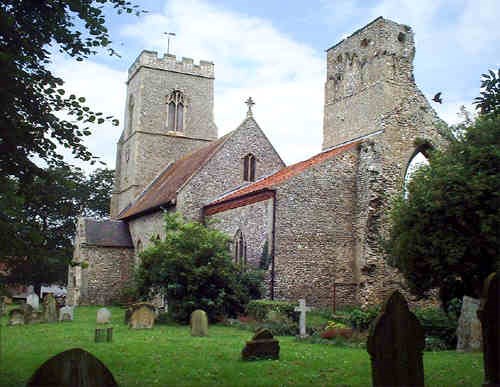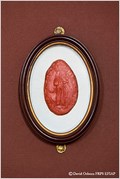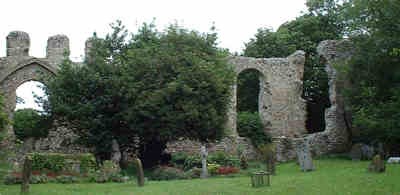
The first church on the current site was built in the 11th century and is likely to have existed for about a hundred years and was of typical Saxon design, having a small nave without an aisle, an axial tower and a chancel.
The Augustinian Order was introduced into England in the 11th century and many houses were founded in the next hundred years. Weybourne Priory was founded between 1200-1216 by Ralph de Meyngaryn and his wife Amicia and was a dependent cell of the older and more important Augustinian house at West Acre, North West of Swaffham. The Canons based here were what the Friars of the 13th century were in towns; “the evangelisers, who came to act as shepherds to the sheep that were in the wilderness, all deserted forgotten and astray”.
A cast of the Priory seal hangs on the wall of the current church in the north aisle. It shows the crowned Virgin standing with a book in her right hand and a fleur-de-lys in her left. At the end of the 12th century the Augustinian Canons demolished the chancel and built a choir in its place. In addition processional access to the cloisters was provided by a doorway through the north wall of the tower. Around the cloisters were built the conventual buildings, among them the refectory, brew house and kitchen. It is also though that belfry windows may have been added to the tower.

Towards the end of the 13th century and with the domestic buildings completed, the Canons concentrated on expanding the church. They built an arcade of three bays opening into a new nave and provided a small chancel. Two of these bays remain today but only the capital of the east pillar is visible, embedded in the north wall of the chancel.
During the early 14th century the Canons further extended the Priory buildings. Both transepts were provided with side chapels. A new chapter house was built on the north side of the cloister. A screen pierced by a central door separated the parishioners from those parts of the Priory used solely by the Canons. Work began on the west tower of the Parish Church and on a south porch, additions which in due course gave a sense of completion at a time of relative prosperity.
When Roger de Hoxne died there was a dispute with West Acre Priory about who should appoint a successor. This was resolved in Weybourne’s favour on payment of an annual pension to West Acre of just over 7 shillings; but by 1422 there were insufficient Canons to form a quorum so the Bishop of Norwich appointed John de Laxford who was prior until 1438.
During the 14th and 15th centuries the western tower was completed and an upper chamber added to the south porch which is likely to have been a chapel used by wayfarers. However, from this time onward the affairs of the Canons languished. The priory had never been well staffed or in good financial health and its importance declined.
By the 16th century much of the priory was in decay. The lead on the roof and the bells in the tower were valued at £60. The hall, buttery, parlour kitchen and brew houses were all poorly furnished and after the dissolution the old nave was allowed to fall into ruin.
In the 19th century Dr Jessopp wrote of a forlorn and poverty stricken building and it remained that way for much of the century. In 1888 the nave was given a new roof and the present north aisle was built upon the foundations of the Saxon nave. A vestry was added and seating was provided in box pews.
The present pews were installed in 1901 and a new floor laid, paid for by a bequest of William Johnson Jennis Bolding, whose family have been major benefactors. He was an eminent Victorian photographer and archaeologist. Being also a farmer, brewer, miller and property owner he was the leading citizen of the village. He lived at the’ Maltings’ (now a hotel) and when he died the property was inherited by his nephew, William Bolding Monement – one of the leading gentleman ‘wildfowlers’ of his day. Many family headstones can be found at the east and west ends of the churchyard.
Also buried in the churchyard are the bodies of six crew members from the SS George Royle which was journeying from the Tyne to St Nazaire but sank off Sheringham during a severe blizzard. The Cromer lifeboat responded to flares but was unable to locate the ship.
With the help of generous bequests much has been done in recent years to maintain the fabric of the church. The West Window has undergone major repairs and new heating was installed in 2001.

If anybody would like to expand to this series please do, I would just ask that you could let Sadexploration know first so he can keep track of the Church numbers and names to avoid duplication
To view the church micro stats page, please click here
There is no designated car park for All Saints. It is safest to park in Church Street and cross the road to view the church. Please bring your own pen or pencil as there is only enough room for a log sheet. Tweezers may be necessary to extract the log.
Please replace exactly as found.